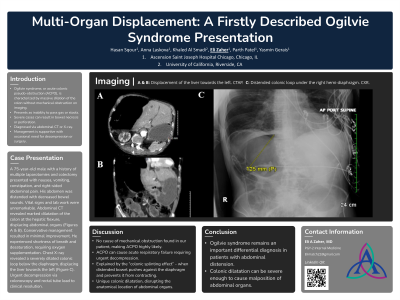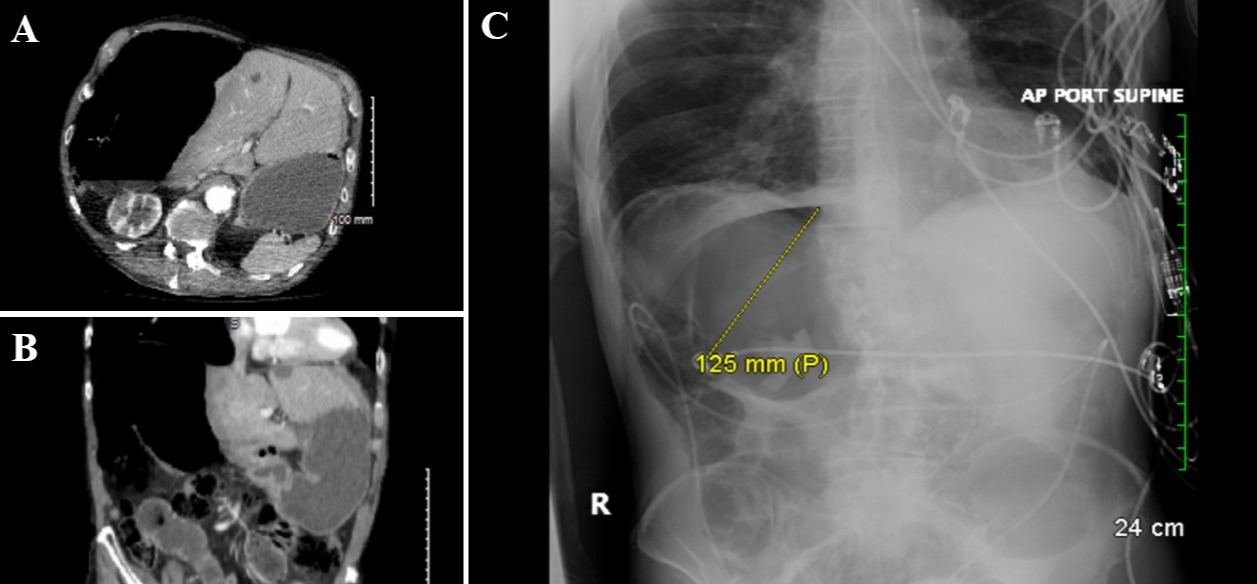Tuesday Poster Session
Category: Colon
P3129 - Multi-Organ Displacement: A Firstly Described Ogilvie Syndrome Presentation
Tuesday, October 24, 2023
10:30 AM - 4:00 PM PT
Location: Exhibit Hall

Has Audio

Eli A. Zaher, MD
Ascension Saint Joseph Hospital
Chicago, IL
Presenting Author(s)
Hasan Sqour, MD1, Anna Laskova, MD1, Khaled Al Smadi, MD2, Eli A. Zaher, MD1, Parth Patel, MD1, Yasmin Gerais, MD1
1Ascension Saint Joseph Hospital, Chicago, IL; 2University of California at Riverside, San Bernardino, CA
Introduction: Ogilvie syndrome, or acute colonic pseudo-obstruction (ACPO), is a rare condition characterized by massive
dilation of the large intestine without mechanical obstruction. Symptoms include abdominal pain, bloating,
nausea, vomiting, and inability to pass gas or have bowel movements. Severe cases can result in
complications such as ischemia, necrosis, or perforation. Diagnosis involves imaging, and treatment aims to
relieve distention and address underlying causes. Non-surgical interventions include supportive measures
and possible decompression with a rectal tube or colonoscopy. Surgery may be required in some scenarios.
We present a unique case of ACPO that led to multi-organ displacement.
Case Description/Methods: A 75-year-old male presented with nausea, vomiting, constipation, and right-sided abdominal pain. He had a surgical history including colectomy for sigmoid volvulus six years ago. Examination revealed a distended abdomen and decreased bowel sounds. Diagnostic studies showed lactic acid of 2.1 mmol/L. Computerized tomography of abdomen and pelvis revealed marked dilatation of the colon at the hepatic flexure, displacing abdominal organs: the liver was in the left upper quadrant, the stomach was squeezed between the organs, and the spleen was malpositioned towards the back [image 1]. He was managed conservatively by IV fluids and NPO. The following day, he had improved abdominal pain but continued to vomit. He experienced shortness of breath and desaturation, requiring oxygen supplementation. A chest X-ray found a severely dilated colonic loop below the diaphragm, displacing the liver towards the left. He had a colonoscopy with decompression using a rectal tube. Saturation improved, vomiting resolved, and the rectal tube was removed. He was subsequently discharged in good condition.
Discussion: We did not find any cause of mechanical obstruction in our patient making the diagnosis of ACPO highly likely. Our presentation highlights that ACPO can cause acute respiratory failure requiring emergent decompression. The uniqueness of our case is that colonic dilatation disrupted the normal anatomy of abdominal organs. Based on previous imaging studies, these were new findings. Therefore, ACPO remains an important differential diagnosis of abdominal distension and, in severe cases, can lead to displacement of abdominal organs.

Disclosures:
Hasan Sqour, MD1, Anna Laskova, MD1, Khaled Al Smadi, MD2, Eli A. Zaher, MD1, Parth Patel, MD1, Yasmin Gerais, MD1. P3129 - Multi-Organ Displacement: A Firstly Described Ogilvie Syndrome Presentation, ACG 2023 Annual Scientific Meeting Abstracts. Vancouver, BC, Canada: American College of Gastroenterology.
1Ascension Saint Joseph Hospital, Chicago, IL; 2University of California at Riverside, San Bernardino, CA
Introduction: Ogilvie syndrome, or acute colonic pseudo-obstruction (ACPO), is a rare condition characterized by massive
dilation of the large intestine without mechanical obstruction. Symptoms include abdominal pain, bloating,
nausea, vomiting, and inability to pass gas or have bowel movements. Severe cases can result in
complications such as ischemia, necrosis, or perforation. Diagnosis involves imaging, and treatment aims to
relieve distention and address underlying causes. Non-surgical interventions include supportive measures
and possible decompression with a rectal tube or colonoscopy. Surgery may be required in some scenarios.
We present a unique case of ACPO that led to multi-organ displacement.
Case Description/Methods: A 75-year-old male presented with nausea, vomiting, constipation, and right-sided abdominal pain. He had a surgical history including colectomy for sigmoid volvulus six years ago. Examination revealed a distended abdomen and decreased bowel sounds. Diagnostic studies showed lactic acid of 2.1 mmol/L. Computerized tomography of abdomen and pelvis revealed marked dilatation of the colon at the hepatic flexure, displacing abdominal organs: the liver was in the left upper quadrant, the stomach was squeezed between the organs, and the spleen was malpositioned towards the back [image 1]. He was managed conservatively by IV fluids and NPO. The following day, he had improved abdominal pain but continued to vomit. He experienced shortness of breath and desaturation, requiring oxygen supplementation. A chest X-ray found a severely dilated colonic loop below the diaphragm, displacing the liver towards the left. He had a colonoscopy with decompression using a rectal tube. Saturation improved, vomiting resolved, and the rectal tube was removed. He was subsequently discharged in good condition.
Discussion: We did not find any cause of mechanical obstruction in our patient making the diagnosis of ACPO highly likely. Our presentation highlights that ACPO can cause acute respiratory failure requiring emergent decompression. The uniqueness of our case is that colonic dilatation disrupted the normal anatomy of abdominal organs. Based on previous imaging studies, these were new findings. Therefore, ACPO remains an important differential diagnosis of abdominal distension and, in severe cases, can lead to displacement of abdominal organs.

Figure: A, B: Displacement of the liver by the colon to the left side. Computerized tomography of abdomen and pelvis.
C: A distended colonic loop under the right hemidiaphragm. Chest X-ray.
C: A distended colonic loop under the right hemidiaphragm. Chest X-ray.
Disclosures:
Hasan Sqour indicated no relevant financial relationships.
Anna Laskova indicated no relevant financial relationships.
Khaled Al Smadi indicated no relevant financial relationships.
Eli Zaher indicated no relevant financial relationships.
Parth Patel indicated no relevant financial relationships.
Yasmin Gerais indicated no relevant financial relationships.
Hasan Sqour, MD1, Anna Laskova, MD1, Khaled Al Smadi, MD2, Eli A. Zaher, MD1, Parth Patel, MD1, Yasmin Gerais, MD1. P3129 - Multi-Organ Displacement: A Firstly Described Ogilvie Syndrome Presentation, ACG 2023 Annual Scientific Meeting Abstracts. Vancouver, BC, Canada: American College of Gastroenterology.
